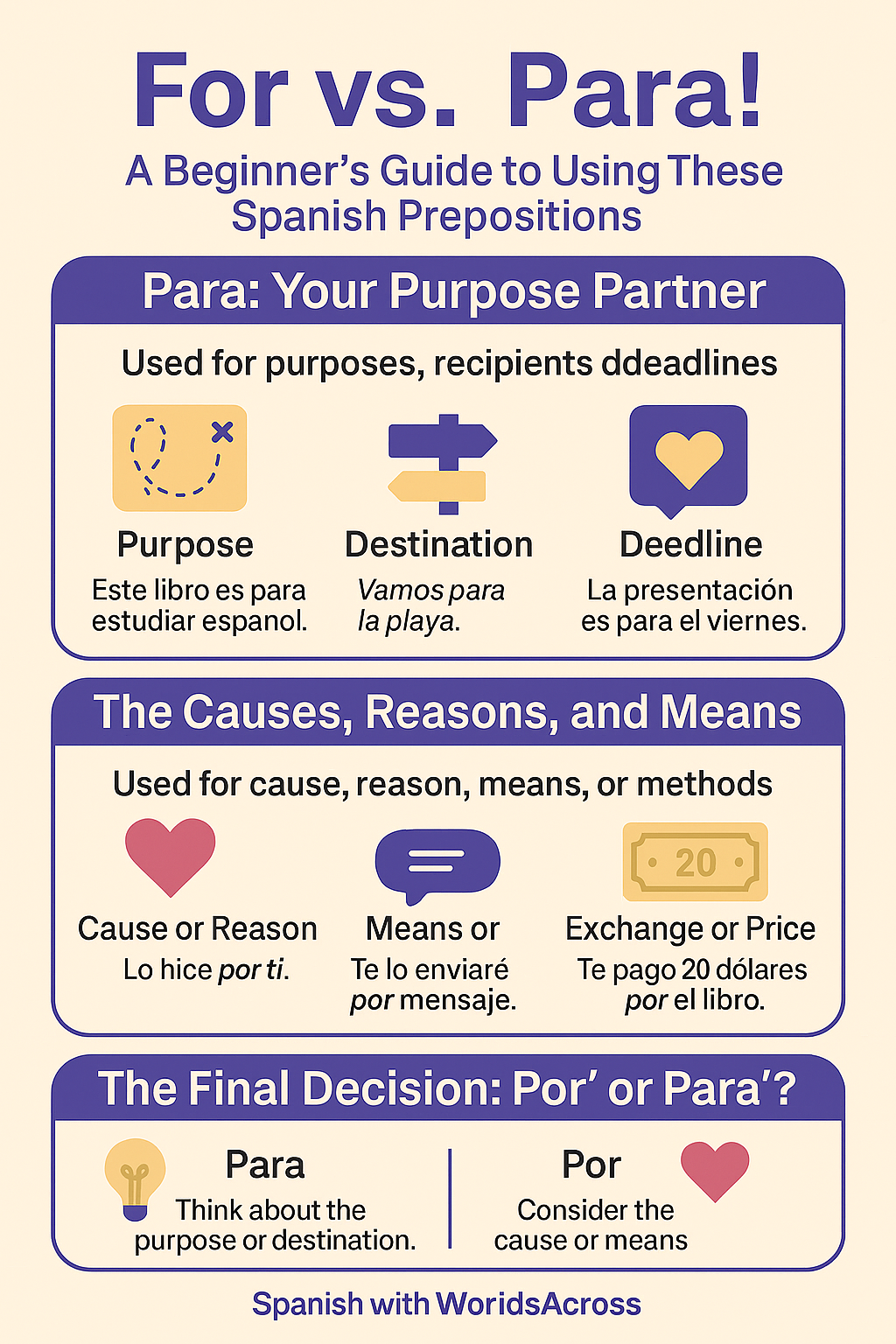Por or Para? How to Use Them Correctly in Spanish

Have you ever hesitated between using "por" vs. "para"? You’re not alone. These two Spanish prepositions can be quite puzzling, but with this guide, you'll unlock the mystery behind their use and see how they become your allies in daily Spanish communication.
Get ready for an engaging and educational journey as we compare "por" vs. "para." Not only will you learn how to use them correctly, but you’ll also enjoy the process. Are you ready for this linguistic adventure? Let's get started!
In the world of Spanish, choosing between "por" vs. "para" is like navigating a treasure map. Imagine you have an old map in your hands: one of those with torn edges and X marks indicating where the chest is buried. One of these paths will lead you straight to the chest (purpose), while the other explains why you're on that quest (cause). Understanding the difference between "por" and "para" is like following the correct clues on that map.
Follow the map and discover the treasure of how to use them!
“Para”: Your Purpose Partner
The Spanish preposition "para" is like your directional guide in Spanish. Think of "para" as a GPS that always knows the best way to reach your destination. It is used to indicate purposes, recipients, and deadlines, guiding you through your sentences with precision. Here’s how to use it in different contexts:
- Purpose: “Este libro es para estudiar español.” Here, "para" tells you the book's purpose. It’s like showing you the arrow pointing directly to the treasure you seek: in this case, improving your Spanish.
- Destination: Traveling? “Vamos para la playa.” Here, "para" takes you directly to your desired destination. Think of this preposition as that road sign telling you to continue towards where you want to be.
- Deadline: “La presentación es para el viernes.” So, "para" helps you remember the deadline for your work. It’s like that reminder in your calendar telling you when to reach your goal.
“Por”: Causes, Reasons, and Means
Now, let’s talk about "por," a Spanish preposition key to understanding the reasons, causes, and means behind actions. If "para" is the GPS taking you to your destination, "por" is the story explaining why you decided to go in the first place. Here’s how to use it in various situations:
- Cause or Reason: “Lo hice por ti.” Here, "por" explains the reason behind your action. Every time you use "por," you're sharing the reason that drives you to act.
- Means or Methods: “Te lo enviaré por mensaje.” "Por" here shows the means through which the action is performed. It’s like that invisible cable connecting your intention with the action, allowing everything to happen.
- Exchange or Price: “Te pago 20 dólares por el libro.” In this case, "por" indicates the exchange you’re making. Think of this preposition as the mediator of a deal.
The Final Decision: “Por” or “Para”?
-
- Para: “El regalo es para ti.” (Indicates purpose.)
- Por: “Lo hice por ti.” (Explains the reason.)
Remember, "para" is used for goals and destinations, while "por" is used for reasons and methods. It’s like choosing between a route on the map and the reason behind your journey. Once you master these Spanish prepositions, you’ll find them flowing more naturally and precisely in your speech.

Tips to Stay on Track
To avoid mistakes and keep your Spanish sharp, here are some practical tips:
- Para: Think about the purpose or destination. What is this for? If you can answer this question, you’ve got a key hint that “para” is the right preposition.
- Por: Consider the cause or means. Why or how is this done? This is your compass for knowing when to use "por."
Try This! Practice creating sentences using both, contrasting "por" vs. "para." Be creative and have fun with it! The more you practice, the more natural it will become to use them.
This Was a Brief Guide to Prepositions
Now you have some tools to use “por” and “para” with confidence. Remember, each practice is a step towards mastering your Spanish. Don’t be discouraged if you make mistakes; they are part of the learning process. If you want to learn more about the use of "por" and "para" and other Spanish prepositions, we’re here to help.
Keep exploring and learning with us! At WorldsAcross, we're here to provide support and resources as you become a language expert. You're not alone on this journey, and we're excited to accompany you every step of the way.




